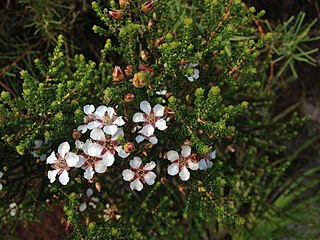
Bursaria is a genus of eight species of flowering plants in the family Pittosporaceae and is endemic to Australia. They are shrubs or slender trees, often with spiny branches and have simple leaves, relatively small flowers with five sepals, five petals and five stamens, and fruit that is a flattened, thin-walled capsule.

Leptospermum squarrosum, commonly known as the peach blossom tea-tree, is an upright shrub of the family Myrtaceae and is endemic to central eastern New South Wales. It has thin, firm bark, broadly lance-shaped to elliptical leaves, relatively large white or pink flowers and fruit that remain on the plant when mature.

Leptospermum turbinatum, commonly known as shiny tea-tree, is a species of spreading shrub that is endemic to the Grampians and nearby ranges in Victoria, Australia. It has thin, rough bark, elliptical to lance-shaped leaves with the narrower end towards the base, relatively large white flowers and fruit that remains on the plant at maturity.

Cadaba aphylla ("Swartstorm") is one of some 30 species in the genus Cadaba. It is indigenous to southern Africa.
Eremophila cordatisepala is a flowering plant in the figwort family, Scrophulariaceae and is endemic to areas of Queensland and the Northern Territory in Australia. It is a small grey shrub with purple to lilac-coloured flowers which have heart-shaped sepals at their base.

Kunzea micromera is a flowering plant in the myrtle family, Myrtaceae and is endemic to the south west of Western Australia. It is a small, sparse shrub, similar in some respects to K. micrantha but has shorter, more rounded sepal lobes. It produces groups of pink flowers on the ends of a few long shoots in spring.

Styphelia perileuca, commonly known as montane green five-corners is a plant in the heath family Ericaceae and is endemic to New South Wales. It is an erect, spreading shrub with broad leaves with a spiky tip, and yellowish-green and red tube-shaped flowers with the petals rolled back. It is only known from the eastern edge of the New England Tableland.

Leptospermum coriaceum, commonly known as green tea-tree or mallee teatree, is a shrub species that is endemic to south-eastern Australia. It has smooth bark on the younger stems, elliptic to narrow egg-shaped leaves, white flowers and woody fruit. The usual habitat is mallee on sand dunes.
Leptospermum benwellii is a species of shrub that is endemic to the Nymboida National Park in New South Wales. It has smooth bark, young branches with conspicuous flanges, narrow elliptical leaves, white flowers and thin-walled, bell-shaped to hemispherical fruit.

Leptospermum crassifolium is a species of shrub that is endemic to the Budawang Range in New South Wales. It has thin, rough bark that is shed annually, broadly elliptic leaves, white flowers borne singly on short side branches, and woody fruit.

Leptospermum epacridoideum is a species of plant that is endemic to a restricted area of the South Coast of New South Wales. It is a bushy shrub with compact bark, elliptical to more or less circular leaves, white flowers arranged singly on short axillary side shoots, and woody fruit.

Leptospermum grandiflorum is a species of shrub or small tree that is endemic to eastern Tasmania. It has thick, elliptical to egg-shaped, greyish green leaves, white flowers about 20 mm (0.79 in) in diameter arranged singly on short side branches, and fruit that remain on the plant for long time after reaching maturity.
Leptospermum luehmannii is a species of shrub or small tree that is endemic to Queensland. It has glossy green elliptic leaves, white flowers and fruit that falls from the plant shortly after the seeds are released.

Leptospermum polyanthum is a rigid, spreading shrub or small tree that is endemic to New South Wales. It has thin, rough bark, young stems that are hairy at first, elliptical leaves, relatively small white flowers and fruit are shed when the seeds are mature.
Leionema scopulinum, is an upright shrub with glossy, dark green, narrow leaves and yellow flowers from autumn to spring. It is found in the Wollemi National Park in New South Wales.

Philotheca papillata is a species of flowering plant in the family Rutaceae and is endemic to a restricted area of New South Wales. It is a small, erect, multistemmed shrub with glandular-warty, narrow elliptic leaves, and white to pale pink flowers arranged singly on the end of the stems.

Commersonia breviseta is a species of flowering plant in the family Malvaceae and endemic to eastern Australia. It is a dwarf shrub with densely-hairy, egg-shaped to narrow elliptic leaves that are paler on the lower surface, and flowers with five white sepals with pink edges, five smaller pale yellow petals and dark red stamens.
Hibbertia pachynemidium is a species of flowering plant in the family Dilleniaceae and is endemic to southern New South Wales. It is a small, mat-forming shrub with oblong to lance-shaped or elliptic leaves and yellow flowers with eight to seventeen stamens arranged around three carpels.

Hibbertia porongurupensis is a species of flowering plant in the family Dilleniaceae and is endemic to a restricted area of the south-west of Western Australia. It is a glabrous shrub with broadly elliptic to more or less round leaves and yellow flowers arranged singly in leaf axils with large numbers of stamens arranged around five carpels.
Bursaria calcicola is a species of flowering plant in the family Pittosporaceae and is endemic to a restricted area near Wombeyan Caves in New South Wales. It is a spiny, hairy, erect or sprawling shrub with clustered, narrowly elliptic to egg-shaped leaves, white flowers with triangular sepals, cream-coloured petals and flattened fruit.













